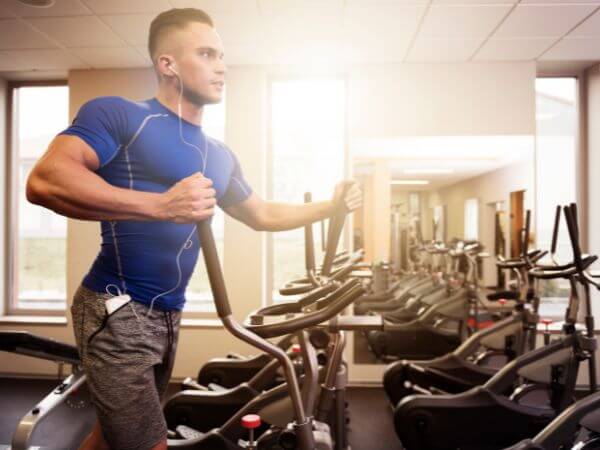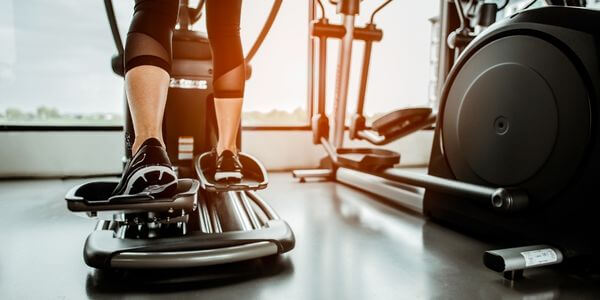The first time I climbed on an elliptical, I noticed a bunch of things happening at once.
First, I noticed that my quads were doing quite a lot of work. Then, my arms didn’t seem to push too much against the resistance. It was more like they were sore from the extra effort.
I also noticed that my abs immediately contracted to keep my stability.
But I was at the gym, my elliptical was positioned in front of a TV screen, and I got lost in the Amazon documentary playing in front of me.
I soon realized that I was pedaling slower and that my shoulders were hunching forward slightly. That meant I couldn’t feel the same core engagement, plus a dull ache in my right shoulder was pulsing its way happily on the gym music beats.
Luckily, I know a thing or two about working out, so I decided to get back in the zone by pedaling backwards.
Table of Contents
Elliptical Backwards: The Workout Programmes
As this was my first time on the elliptical, I wasn’t sure what moves fit better and the sequence I should execute them in. I had already tried to pedal by myself, but watching that documentary made me zone out.
Side note: Zoning out is sometimes good when you exercise.
If you want to relax after a hard day at work or if you want to blow off some steam, the last thing you want is counting sets or reps.
But zoning out can also be dangerous when it increases your risk of injury because you’re no longer paying attention to your form.
That’s what happened to me.
I was also beginning to move slower, which is totally fine if you want a workout that moves your body and relaxes your brain. But that wasn’t my goal that day.
I went on the elliptical to work hard, get sore, and achieve that sweet post-workout dopamine release.
But I wasn’t familiarised with the elliptical well enough to set my own routine. Consequently, I decided to browse elliptical backwards workout programs.
I could do that because I was on a gym-quality elliptical with different built-in workouts. Cheaper or older ellipticals might not include as many options.
Don’t worry; I’ll tell you what my program looked like so you can create one for yourself.
I was pleasantly surprised to find different backward-walking programs on my elliptical, grouped in several categories.
These categories were:
- Hill walking
- Endurance
- HIIT
Now, I’m a big fan of HIIT because it doesn’t slow down your metabolism like steady-state cardio. I have some autoimmune metabolic issues that I’m keeping under control with medication. However, I have to also watch my exercise routine. I need to keep my cortisol in check (the stress hormone) and ensure I’m not slowing down my metabolic rate.
HIIT has other advantages for me.
For example, I like that I can work very hard during high-intensity intervals because they’re so short. So I always feel great after finishing such an interval. And I can rest during the lower-intensity ones.
Medium story long, I chose the HIIT programs.
This section had a slew of other options too, but I chose the fat-burning one. Even if I don’t dislike my body composition, my built-in programming still plays an important role.
That aside, here’s what the fat-burning HIIT elliptical backwards workout looked like:
- 4 intervals: warm-up; front pedaling
- 2 intervals: backwards pedaling
- 3 intervals: front pedaling
- 2 intervals: backwards pedaling
- 3 intervals: front pedaling
- 2 intervals: backwards pedaling
- 3 intervals: front pedaling
- 2 intervals: backwards pedaling
- 3 intervals: front pedaling
- 2 intervals: backwards pedaling
- 4 intervals: cool-down; front pedaling
Elliptical Backwards Benefits

First, there are 30 intervals that the machine adjusts depending on how long you want your routine to last.
If you have 30 minutes for your day’s workout, each interval will last for a minute. If you only plan to exercise for 10 minutes, each interval will last 20 seconds.
So that’s a big plus because you still get all the benefits of HIIT even if you have less time available.
Second, I immediately noticed that I could focus more on my front pedaling. I kept an eye on my stats, and I could adjust my speed and resistance according to what my body told me.
Elliptical Backwards Drawbacks
I’m used to working out on a treadmill. I do strength training twice a week, cardio one day per week, and stretching on the fourth day. I also keep myself active on the other days.
That said, I like that I can start the treadmill, choose the program, and the machine adjusts automatically to that workout.
Stationary bikes are the same. The bike adjusts automatically when the program begins at a higher speed or resistance.
But not the elliptical. At least not the one I was on.
So, when the backward intervals began, I simply had to pedal backward myself. Granted, the program didn’t resume if I was front pedaling.
However, the elliptical didn’t increase in resistance or incline (yes, mine also had an incline option).
That’s a disadvantage for beginners because you can easily slow down unconsciously. That means you won’t be challenging yourself correctly.
You have to take charge.
The first time you pedal backward, the movement seems pretty off compared to what you’re used to. However, you will achieve good coordination with time and practice, especially if you make a conscious effort to continue.
And that’s actually pretty good for your brain.
Numerous studies prove that exercising regularly improves brain functioning, especially if you try to be mindful while doing that.
Again, zoning out occasionally can also be beneficial if it helps you relax. But staying present has its advantages too.
Elliptical Backwards: The Muscles Worked

As I told you above, working out on an elliptical initially felt weird to me. My first sensation was that my quads were doing all the work, so I wasn’t too happy that my butt and arms were just tagging along.
Thanks to my genetics, those two areas in my body need additional sculpting.
But I’m not the only one. Many people crave rounded bums and slimmer arms.
After consoling myself this way, I continued using the elliptical to see how my body responded. Then the whole zoning out phase followed, after which I started the elliptical backwards program.
When the first backwards interval started, I noticed that:
- My quads were making an even more intense effort than at the beginning.
- My calves were beginning to fire up.
- My core was less engaged.
- My arms were not working as hard as during the front pedaling intervals.
When I switched back to front pedaling, I noticed that my butt worked harder than I initially thought.
But this change in movements also led me to realize something else:
I could consciously change the way my body was moving. That meant I could target different muscles better while on the elliptical.
So, I started to:
- Land in different ways. When you’re at the bottom of that circular motion, it’s important where you put pressure on your sole. If you land more on the front of your soles (aka toes and midsole), your quads must work harder. If you land more on your heels, the hamstrings, calves, and butt work more.
- Use my arms consciously. When you’re on the elliptical for the first time, you tend to use it like a bike. That means your legs tend to do most of the work while your arms simply tag along, holding onto the handlebars. Instead, I focused on consciously letting my arms take much of the weight my legs were handling. That’s when I started feeling my triceps, biceps, and chest working out like mad.
I continued to consciously listen to my body and do micro-adjustments during the backward intervals.
I contracted different muscle groups and tried different grips and steps to activate specific muscles. After the workout was over, I was pretty much done too.
Here are two other things to consider:
The Internet
If you’re old enough to read this, you’re old enough to know that the Internet is filled with BS. That means you’ll find much contradictory information on the muscles worked by an elliptical.
And even more about muscles worked by an elliptical when pedaling backwards.
That BS isn’t always the result of poor research (though it sometimes is). It’s also the result of the fact that:
- People’s bodies work differently even when using the same machine with the same settings.
- Writers may try to apply their personal experiences to everyone.
That’s why I’m such a passionate advocate for listening to your body. That means being perfectly in tune with you’re moving and adapting those movements in the future to benefit you.
If you want to read a more in-depth piece about muscles worked by an elliptical and how you can make different adjustments for your needs, check out this article.
The Workout Programme

If the elliptical backwards HIIT program I was on punished my quads so much, I could only imagine what an added incline might do to them.
Of course, I tested that for myself.
After several pedaling forward and back intervals, I increased the incline slowly.
Side note: My gym elliptical has a wide range of incline levels, and they’re also separated by tiny increments. That means you can slowly adjust the intensity, tweaking it until you find the best resistance for your needs. And that’s what you have to look for in an incline elliptical if you’re planning to purchase one for home use.
After increasing the incline, I noticed that my whole body was firing. Even my arms (especially my triceps) and lower back muscles had to work much harder to ensure my stability.
And my quads were torched.
Apart from the incline, different programs will activate your muscles differently. It also depends on how well you’re minding your body consciously and adapting the speed.
That brings us to the next point:
Elliptical Backwards: Calorie Burn
If I remember correctly, I burnt 100 calories during 15 minutes on my elliptical backwards program.
That’s 35 calories less than the expected standard, but:
- I have that preexisting metabolic condition, which you may not. Even if it’s now completely under control with medication – I’m not a doctor/scientist. Who knows if and how it can still influence my exercise performance.
- My backwards pedaling on the elliptical used up 20% fewer watts than my front pedaling. That constantly happened throughout my workout, even when I consciously tried to increase my speed.
- I didn’t push myself at the maximum level of intensity because I was aiming to maintain a correct posture. That’s what I advise you to do at first when you’re just getting acquainted with a machine or new type of workout. Start slowly until you feel you’re in control and until you have mastered the correct form without thinking about it.
However, other calculators claim that riding the elliptical at a moderate pace only burns 350-450 calories per hour, meaning 87.5-112.5 calories/ 15 minutes.
Therefore, my calorie burn was smack in the middle of this interval.
That’s not the point, though.
You should try to listen to your body (again, I’m repeating myself) and maximize your challenge without focusing on the calorie burn. Numerous studies show that your daily activity helps you create a more significant calorie deficit than exercise.
A typical 60-minute workout might burn 500 calories.
But that’s useless if you’re a couch potato during the rest of the day.
Besides, pedaling backwards on the elliptical keeps your body guessing, especially if you’re doing interval training. That means you’re not slowing down your metabolic rate.
If you’re also increasing the resistance, speed, and incline to your needs, you’re maximizing the afterburn effect.
So your body will continue to fry those calories long after your workout is done.
Wrap Up
I found the whole experience of pedaling backwards on the elliptical useful. Firstly, I always enjoy to somehow watch my own brain thinking and firing up when I try new things.
Secondly, that first particular backwards elliptical training was a comprehensive warm-up for a 30-minute strength training routine.
Of course, it could have made an excellent standalone workout, especially if I had followed it with another 5-10 minutes of relaxing stretches.
But that said, I’m pretty happy with how an elliptical can work my body, especially if I’m incorporating backwards pedaling, plus speed and incline adjustments. The only thing to remember (apart from choosing a feature-packed elliptical) is to remain present throughout your workout and make the necessary adjustments according to what your body is trying to tell you.
So, if I made you curious, go ahead and try backwards pedaling on the elliptical. But remember to come back here and tell me how it went.
- Here’s What Doing Cardio Every Day Does To Your Body - August 21, 2024
- How To Lose Weight (Without Exercising or Dieting) - August 21, 2024
- How to Get Rid of Belly Fat (Without Crunches) - August 21, 2024

